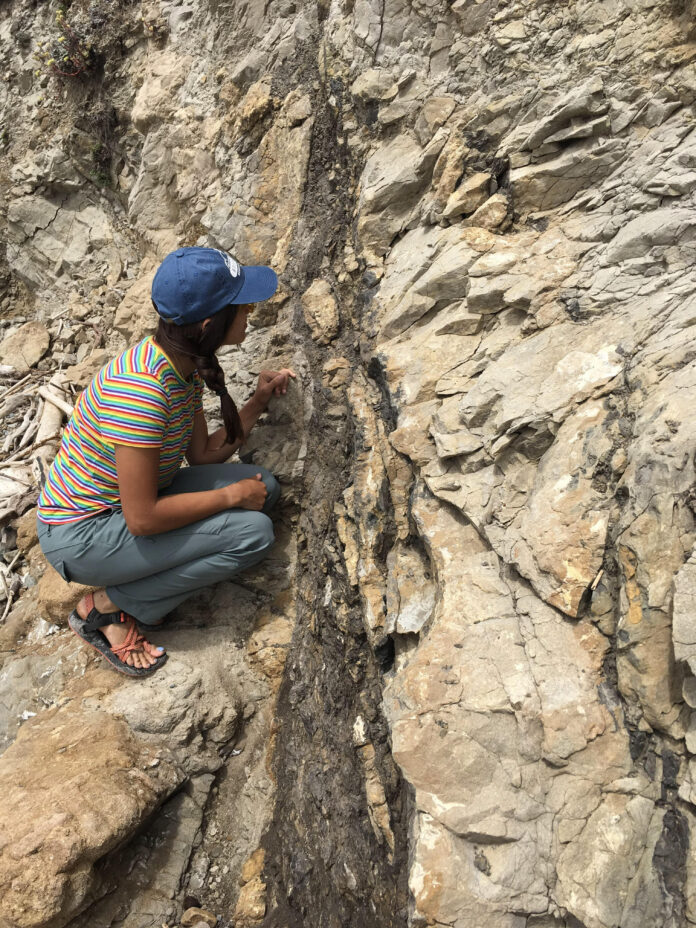Alba Rodríguez Padilla studies the physics and geology of earthquakes, focusing on off-fault deformations and earthquake gates
By KATIE HELLMAN— science@theaggie.org
Alba Rodríguez Padilla, a doctoral student in UC Davis’s Department of Earth and Planetary Sciences, has studied earthquakes in the lab of Geology Professor Michael Oskin for the past five years.
“In the lab, we do data analysis, [… and] data collection in the field; we will map things, we will excavate for samples, we will measure how things have been deformed, and sometimes we’ll dig quite extensive excavations across faults to understand their history,” Oskin said.
Under Oskin’s mentorship, Rodríguez Padilla has worked on multiple projects involving the physics and geology of earthquakes. These include a project about off-fault deformations that focuses on the cracks that build up in the Earth with each new earthquake, as well as another project concerning zones of geometrical complexity along faults called earthquake gates.
“The first [direction of research] is trying to understand what causes earthquakes to stop,” Rodríguez Padilla said. “So how the shape of a fault helps or doesn’t help an earthquake. The other line of work that I pursue is looking at how much of the deformation during an earthquake is accommodated over really, really large volumes of the crust of the Earth, like how far cracks extend from a fault during an earthquake.”
Rodríguez Padilla utilizes remote sensing technology and geological records, funded by a $90,000 fellowship from NASA’s Future Investigators in NASA Earth and Space Science and Technology (FINESST) program, to generate probabilistic models. These models predict whether an earthquake will be stopped by analyzing the geometric complexity of faults. Her research is utilized in multiple career fields, from policymakers creating earthquake insurance policies to engineers developing safer infrastructure.
During her time earning a bachelor of arts in human ecology at Maine’s College of the Atlantic, Rodríguez Padilla studied under the mentorship of Earth Science Professor Sarah Hall.
“We were looking a lot at fractures and faults, so we’d go out in the field with a compass and GPS and use tools for mapping,” Hall said. “My Ph.D. research and work that [Rodríguez Padilla] was a part of was in the Andes and mostly in coastal Peru where there are active faults. In that work, we were using a lot of surveying equipment to make high-resolution maps of surface features that were offset, and we could measure how much offset there was along a fault during an earthquake.”
During that time, Rodríguez Padilla explored geological landforms like glaciers and volcanoes and realized that she was passionate about the physics driving these natural processes. She decided to come to UC Davis after graduation, in part because its location in California provided her the opportunity to study in the U.S. state that has historically had the most earthquake damage, according to the United States Geological Survey (USGS).
Aside from doing her own research, Rodríguez Padilla is a mentor for the Southern California Earthquake Center, a research organization funded by the National Science Foundation and the USGS. Rodríguez Padilla has also participated in UC Davis’s GEL 199, an advanced research course for undergraduates, as a mentor to students in the same way that she was supported by her own mentors and other geologists. Looking forward, Rodríguez Padilla hopes to focus her research on the warning signs of future earthquakes.
“We’re realizing that the time in between earthquakes is not a time of silence,” Rodríguez Padilla said. “Faults are doing things during that time, so I want to start looking at really, really subtle signals of faults during the period leading up to earthquakes. There may be information there that helps us understand a little bit better how faults get ready for a big earthquake.”
Written by: Katie Hellman — science@theaggie.org




